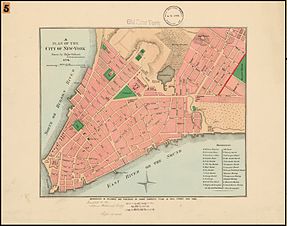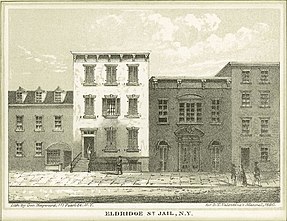
Ira Gershwin was an American lyricist who collaborated with his younger brother, composer George Gershwin, to create some of the most memorable songs in the English language of the 20th century. With George, he wrote more than a dozen Broadway shows, featuring songs such as "I Got Rhythm", "Embraceable You", "The Man I Love" and "Someone to Watch Over Me". He was also responsible, along with DuBose Heyward, for the libretto to George's opera Porgy and Bess.
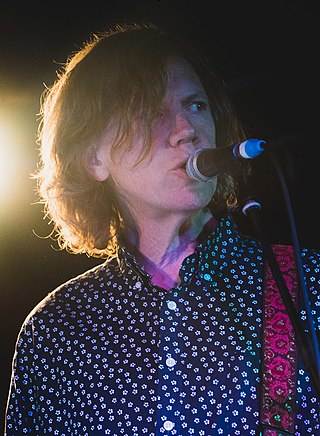
Thurston Joseph Moore is an American guitarist, singer and songwriter best known as a member of the rock band Sonic Youth. He has also participated in many solo and group collaborations outside Sonic Youth, as well as running the Ecstatic Peace! record label. Moore was ranked 34th in Rolling Stone's 2004 edition of the "100 Greatest Guitarists of All Time".

Kim Althea Gordon is an American musician, singer and songwriter, best known as the bassist, guitarist, and vocalist of alternative rock band Sonic Youth. Born in Rochester, New York, she was raised in Los Angeles, California, where her father was a professor at the University of California, Los Angeles. After graduating from Los Angeles's Otis College of Art and Design, she moved to New York City to begin an art career. There, she formed Sonic Youth with Thurston Moore in 1981. She and Moore married in 1984, and the band released a total of six albums on independent labels before the end of the 1980s. They would subsequently release nine studio albums on the major label DGC Records, beginning with Goo in 1990. Gordon was also a founding member of the musical project Free Kitten, which she formed with Julia Cafritz in 1993.

Forsyth Street runs from Houston Street south to Henry Street in the New York City borough of Manhattan. The street was named in 1817 for Lt. Colonel Benjamin Forsyth.

Sonic Youth is the debut EP by American rock band Sonic Youth. It was recorded between December 1981 and January 1982 and released in March 1982 by Glenn Branca's Neutral label. It is the only recording featuring the early Sonic Youth lineup with Richard Edson on drums. Sonic Youth differs stylistically from the band's later work in its greater incorporation of clean guitars, standard tuning, crisp production and a post-punk style.
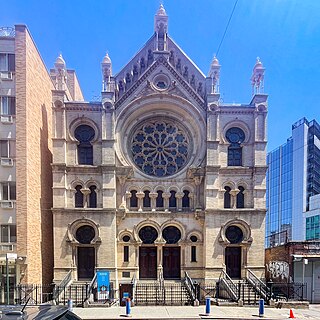
The Eldridge Street Synagogue is an Orthodox Jewish synagogue at 12 Eldridge Street, in the Chinatown and Lower East Side neighborhoods of Manhattan in New York City, New York, U.S. Built in 1887 for Congregation Kahal Adath Jeshurun, the synagogue is one of the first erected in the U.S. by Eastern European Jews. The congregation, officially known as Kahal Adath Jeshurun with Anshe Lubz, still owns the synagogue and hosts weekly services there in the 21st century. The Museum at Eldridge Street, founded in 1986 as the Eldridge Street Project, also occupies the synagogue under a long-term lease. The building is a National Historic Landmark and a New York City designated landmark.

The Robb House, located at 23 Park Avenue on the corner of East 35th Street in the Murray Hill neighborhood of Manhattan, New York City is a townhouse built in 1888-92 and designed in the Italian Renaissance revival style by McKim, Mead & White, with Stanford White as the partner-in-charge.
The Collectors Club, often referred to as the Collectors Club of New York, is a private club and philatelic society in New York City. Founded in 1896, it is one of the oldest existing philatelic societies in the United States. Its stated purpose is "to further the study of philately, promote the hobby and provide a social, educational, and non-commercial setting for the enthusiastic enjoyment of our common passion".

The Bialystoker Synagogue is an Orthodox Jewish synagogue at 7–11 Bialystoker Place in the Lower East Side neighborhood of Manhattan in New York City, New York, United States. The building was constructed in 1826 as the Willett Street Methodist Episcopal Church; the synagogue purchased the building in 1905.

Grand Street is a street in Lower Manhattan, New York City. It runs west/east parallel to and south of Delancey Street, from SoHo through Chinatown, Little Italy, the Bowery, and the Lower East Side. The street's western terminus is Varick Street, and on the east it ends at the service road for the FDR Drive.

Henry Street is a street in the Lower East Side of the New York City borough of Manhattan that runs one-way eastbound, except for two small two-way segments west of Pike Street and east of Montgomery Street. It spans from Oliver Street in the west, passing underneath the Manhattan Bridge and on to Grand Street in the east ("north"). The street is named for Henry Rutgers, a hero of the American Revolutionary War, and prominent philanthropist. Rutgers Street, which intersects with Henry Street, is also named for him.

Beth Hamedrash Hagodol is an Orthodox Jewish congregation that for over 120 years was located in a historic building at 60–64 Norfolk Street between Grand and Broome Streets in the Lower East Side neighborhood of Manhattan, New York City. It was the first Eastern European congregation founded in New York City and the oldest Russian Jewish Orthodox congregation in the United States.

Division Street is a one-way street in the Two Bridges neighborhood of Lower Manhattan in New York City. It carries westbound traffic from the intersection of Canal Street and Ludlow Street westward to Bowery.

Scheffel Hall at 190 Third Avenue in the Gramercy Park neighborhood of Manhattan, New York City, was built in 1894–1895, and designed by Henry Adams Weber and Hubert Drosser, at a time when the area south of it was known as Kleindeutschland due to the large number of German immigrants who lived nearby. The building, which served as a beer hall and restaurant, was modeled after an early 17th-century building in Heidelberg Castle, the "Friedrichsbau", and was named after Joseph Viktor von Scheffel, a German poet and novelist. It later became known as Allaire's, a name still inscribed on the building. The building's style has been described as "German-American eclectic Renaissance Revival".

The St. Aloysius Catholic Church is a Catholic parish in the Archdiocese of New York, located at 209-217 West 132nd Street between Adam Clayton Powell Jr. Boulevard and Frederick Douglass Boulevard in the Harlem neighborhood of Manhattan, New York City.

The Yiddish Theatre District, also called the Jewish Rialto and the Yiddish Realto, was the center of New York City's Yiddish theatre scene in the early 20th century. It was located primarily on Second Avenue, though it extended to Avenue B, between Houston Street and East 14th Street in the East Village in Manhattan. The District hosted performances in Yiddish of Jewish, Shakespearean, classic, and original plays, comedies, operettas, and dramas, as well as vaudeville, burlesque, and musical shows.

Alexander Saeltzer was a German-American architect active in New York City in the 1850s and 1860s. His work includes the Anshe Chesed Synagogue, Academy of Music, Theatre Francais, the Duncan, Sherman & Company building and the South Wing of the Romanesque revival structure at 425 Lafayette Street built between 1853 and 1881 as the Astor Library.

The Treadwell Farm Historic District is a small historic district located on parts of East 61st and East 62nd Street between Second and Third Avenues, in the Upper East Side neighborhood of the borough of Manhattan in New York City.

The Adath Jeshurun of Jassy Synagogue and later, the Erste Warshawer Synagogue is a former Orthodox Jewish synagogue located at 58-60 Rivington Street near Eldridge Street on the Lower East Side of Manhattan, New York City, in New York, in the United States. The former synagogue was designed by architect Emery Roth, and completed in 1904 in the Moorish Revival style.
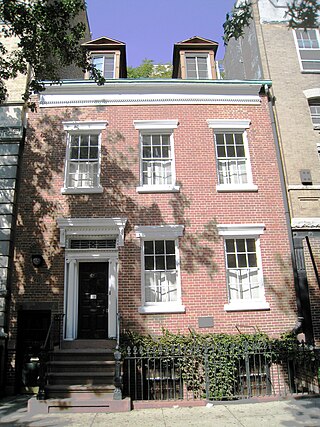
Charles Street is a street in the West Village neighborhood of Manhattan in New York City. It runs east to west from Greenwich Avenue to West Street. The street was named after Charles Christopher Amos, who owned the parcel the street passed through. Amos is also the namesake of Christopher Street, two blocks to the south, and the former Amos Street, which is now West 10th Street. Charles Lane is a one-block alley located between Charles and Perry Streets and Washington and West Streets. From 1866 to 1936, the section of Charles Street between Bleecker Street and West 4th Street was called Van Ness Place after a farm, owned by the Van Ness family, which had occupied the square bounded by Bleecker, West 4th, Charles and Perry Streets until 1865.
